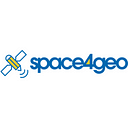- In your experience, what skills are needed to improve the dialogue between public users and space/geospatial experts providing the services?
Ms Gomez Miguel: Some skills have to be improved from both the sides to have a fulfilling dialogue between parts. First of all, public users need a basic understanding of the EO related products and of the ICT tools for EO products analysis. They also need a good knowledge about the space mission operation schema within all the process, from planning to delivery. Public users should also handle the definition of the requirement (based both on cases definition and testing approach) and develop methodologies based on short loops.
From the other side, also space/geospatial experts should improve their skills in several fields. A better user requirement analysis is needed, to generate technical specifications, as much as the calculation and validation of the EO product performance parameters. Another necessary skill is the capacity to understand the basic operational needs, as target goals variability and availability. Interface handling is also a needed skill for the experts, as the data and information processing and fusion (from EO and auxiliary data gathering up to GUI) and the validation of the implementation based on use cases. To generate little capabilities demonstrators, based on available tools or platforms, and to develop methodologies based on short loops are other responsibilities of the experts.
Ms Martins: This is not an easy question. There was in 1998 a world satellite conference in Lisbon where similar questions were made to EO scientists present. The question was: “how could general public relate and understand the importance of space/geospatial products, particularly those obtained by sensors aboard satellite systems?”. Twenty years later, this question is still very pertinent, especially if we think in terms of EO and not GNSS. GNSS applications are easier to understand or perceive by general public, since the use of smartphones became very normal even in less developed regions of the world. On the other hand, it is much more difficult to explain public users how EO services can help their daily tasks and, particularly, how can public users manipulate and/or understand this data.
Therefore, it is fundamental that both public users and EO experts get together regularly. It is essential to establish short-term but regular courses, where the basic principles of EO and derived products can be administered to public users, so they can understand the EO products and at the same time express the difficulties they feel in interpreting these products. For many other professional fields this concept is quite natural: users have to keep up with these courses to exercise efficiently their profession.
The dialogue has to be continuously open, kept simple and attractive to public users, to have them interested in learning how to use EO products for their own profession and day to day life.
2. Marine-EO aims to bring innovation in the field of maritime awareness, leveraging the Copernicus Services. Could you propose two examples of how EO4GEO and MARINE-EO could collaborate concretely to bridge the gaps between the space/geospatial sector and the marine one?
Ms Gomez Miguel: MARINE-EO and EO4GEO have much in common. Marine-EO training material can be tailored to become training material for EO4GEO: even some of the operational validation trials can become part of the EO4GEO material. Moreover, partners from the Marine-EO consortium could become participants in EO4GEO workshops and some of them could respond to EO4GEO call for experts.
Ms Martins: Firstly, it is fundamental to list and identify major gaps and challenges experienced by the marine scientific sector by now, than wonder how these problems could be linked and/or answered by the space/geospatial sector (through the development of new sensors, technologies, processing algorithms, etc). This goal could be achieved by proposing annual (or biennial) major conference with these specific objectives in mind. Marine scientists could express their concerns, problems and difficulties experienced by using satellite technology for EO studies, while EO technology developers could discuss new ideas and solutions for them.
3. Space technologies, such as Earth Observation, are increasingly being applied in other industrial sectors: how can this “trans-sectoral dimension” be included in sectoral curricula and related skills strategies? Provide one example for the marine sector.
Ms Gomez Miguel: Development platforms can be a place for trans-sectoral technology transfer: their use should be included in curricula. Although they are not specific examples for the marine sector, I mention Sentinel Hub and DIAS. ESA’s cloud based Sentinel Hub by SINERGISE allows satellite image visualization and support specific developments that can be implemented for different applications and easily applied to any kind of sensor images. DIAS (Data and Information Access Services) is a platform that acts as data and information access points, where different actors can implement and share applications.
Ms Martins: All courses (license, master and PhD degrees) in the marine sector should include at least one regular discipline based on space technologies, such as “Satellite Oceanography”, “Remote Sensing”; “Application of Space Technologies to study the Ocean”, etc. This knowledge is essential in the marine field, because nowadays it is almost impossible to speak about ocean studies without incorporating satellite imagery. For those students that were never exposed to this field, it is very difficult to understand what type of information they can obtain from a scene/data. They cannot understand how this binary data is formatted, how was really acquired, how deep a sensor penetrated in the ocean, etc. This means that they experience severe difficulties to understand how they can use this data to their research studies. Space Technologies should not be an optional subject, but it must become a compulsory discipline for those who want to follow marine studies.
